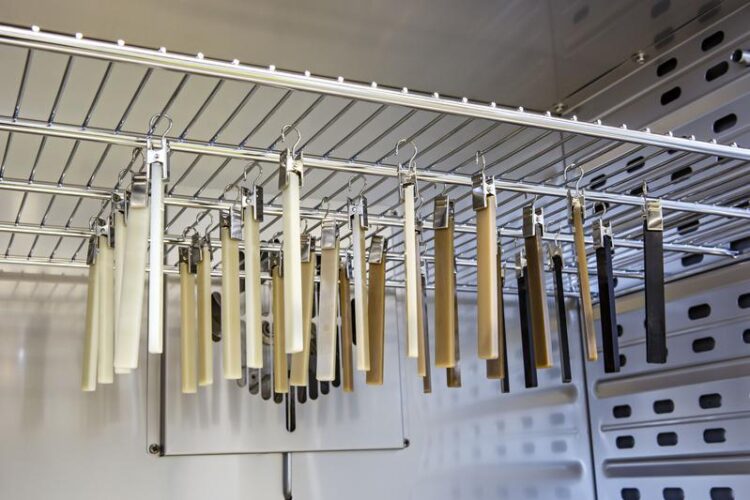Short- and long-term properties in recyclates

The aging properties of post-consumer recyclates (PCR) will be assessed early in the development phase as part of the new collaborative project.
Credit: Ursula Raapke / Fraunhofer LBF
Project idea seeks partners.
With the project “Material and long-term properties in recycled materials”, Fraunhofer LBF is looking for additional partners to jointly develop fundamental insights into the effect of material composition. Focus is on the feedstocks and the variables influencing compounding (e. g. proportion and condition of virgin material, re-additivation) on the resulting application properties. This is supported by a toolbox with customized analysis methods that visualize fundamental dependencies between molecular parameters and properties. In this way, the project participants obtain the necessary know-how for optimal control of their material flows.
Legislative measures on both European and national level demand to significantly increase the proportion of recyclates, also in technically demanding applications. Therefore, sustainable solutions are called for by the plastics industry. The Fraunhofer Institute for Structural Durability and System Reliability LBF aims to lay the foundations for increasing the proportion of post-consumer recyclates (PCR) for high-quality industrial applications of engineering plastics.
More recyclates in technically demanding applications
While post-industrial recyclates (PIR) are well defined regarding their composition, the diversity of possible compositions (e.g. polymeric impurities, non-plastic impurities, additives, adhesives) increases exponentially when moving to post-consumer recyclates. Also, various states of aging need to be considered, as well as fluctuations according to seasonal and geographic origin. Such varying quality of the incoming streams will affect the quality of the resulting products. For example, the properties of the compounds regarding processing behavior and the mechanics of the products generally deteriorate when the fraction of PCR is increased. Also, the durability and as a result, the life expectancy of the products are affected in a negative way. Thus, the state of the material stream and the applied technologies with regard to sorting and workup play a key role in the quality of the resulting recyclates. Compounders have the possibility to further optimize the quality and the resulting product properties by using a range of tools. This includes, for example, specific re-additivation, adapting processing conditions, or raising the portion of virgin materials.
Identifying and evaluating secondary materials suitable for extrusion i.e., sorted and cleaned flakes or ground materials, requires considerable effort. The subsequent steps, like characterization, homogenization, and quality control, pose a significant technical effort and need resources, and thus require the availability of larger batches. Looking further down the line, the variables of the compounding (formulation, process) raise the complexity once more. As a result, it becomes only clear in the very late stages of the development cycle if and how the targeted properties (aging resistance, mechanics) can be achieved and if these are consistently under control considering further variables (batch-to-batch variation, incoming streams). Thus, trial and error are still widely used in this process.
Early detection of dependencies
Within the scope of the project, in-depth know-how of the relationship between the confection (e.g., granules, ground material), the chemical composition of the input streams shall be established on the one side, and the resulting properties of the products. This includes for example the mechanical properties and the durability in various environments. Within this context, special focus will also be laid on the variable parameters during compounding. On the polymer side, the emphasis will be on condensation plastics, like polyamides (PA), polyethylene terephtalate (PET) and polycarbonate (PC). Considering individual application profiles, representative formulations will be produced from selected recyclates and established additives at LBF. The recyclate streams will be fingerprinted regarding their molecular parameters, which are relevant to the processing and application properties. Here, attention will be given to the chemical composition regarding polymer and nonpolymeric components, any additives, and the molecular weight distribution. Starting from the information gathered, structure-property relationships will be derived. The aim is to identify dependencies between the mechanical and rheological properties and the long-term behavior (e.g. aging) when using post-consumer recyclates of selected engineering thermoplastics. Furthermore, these insights shall be transferred for estimation and forecast for similar compositions.
The project is open for further partners from industry.
Wissenschaftliche Ansprechpartner:
Dr. Frank Schönberger, frank.schoenberger@lbf.fraunhofer.de
Weitere Informationen:
http://www.lbf.fraunhofer.de/en/research-projects/material-and-long-time-propert… Details to the focus areas and the further procedure
http://www.kunststoffrezyklate.de More Information also at “Forum Plastic Recyclates”, March 29 and 30, 2023, Darmstadt
Media Contact
All latest news from the category: Materials Sciences
Materials management deals with the research, development, manufacturing and processing of raw and industrial materials. Key aspects here are biological and medical issues, which play an increasingly important role in this field.
innovations-report offers in-depth articles related to the development and application of materials and the structure and properties of new materials.
Newest articles

Trotting robots reveal emergence of animal gait transitions
A four-legged robot trained with machine learning by EPFL researchers has learned to avoid falls by spontaneously switching between walking, trotting, and pronking – a milestone for roboticists as well…

Innovation promises to prevent power pole-top fires
Engineers in Australia have found a new way to make power-pole insulators resistant to fire and electrical sparking, promising to prevent dangerous pole-top fires and reduce blackouts. Pole-top fires pose…

Possible alternative to antibiotics produced by bacteria
Antibacterial substance from staphylococci discovered with new mechanism of action against natural competitors. Many bacteria produce substances to gain an advantage over competitors in their highly competitive natural environment. Researchers…





















